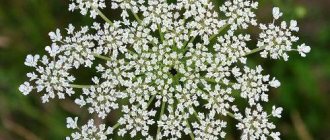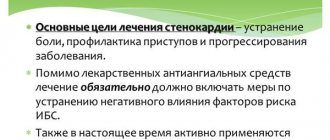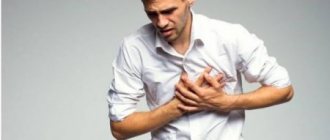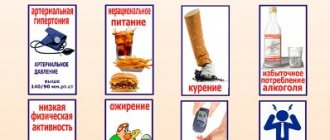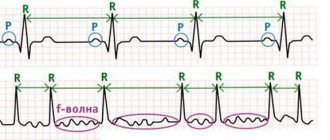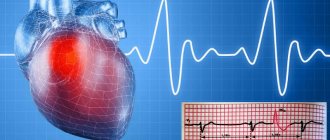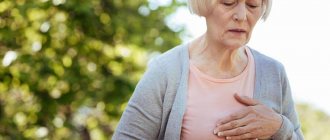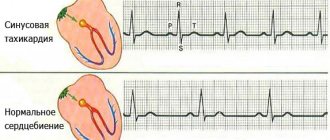Coronary heart disease or angina pectoris refers to a pathology that develops due to insufficient oxygen saturation of the muscle tissue of the organ. The first signs of the disease indicate a circulatory disorder, which quickly progresses without treatment. Using emergency care for angina pectoris, you can reduce the discomfort of pain or prevent acute heart failure.
Develops due to insufficient oxygen saturation of the muscle tissue of the heart.
Peculiarities
In men, angina with further symptoms occurs 4 times more often than in women. Most cases of pathology development are observed in patients over the age of 40 years, but recently ischemia has been diagnosed in people in a younger age category.
Classification
In cardiology, stable, unstable angina and Prinzmetal ischemia are distinguished. In all cases, prompt assistance will be required.
Depends on individual tolerance to physical or emotional stress.
Stable pathology. Does not change its course, depends on individual tolerance to physical or emotional stress. Classes are used to determine the severity of stable angina. They include a description of the load levels at which an attack develops.
Often acts as a precursor to a heart attack.
Unstable pathology. The course of the disease has several variations. Symptoms occur regardless of whether the person is currently under strain. The manifestation of pain syndromes is possible at rest. This type of ischemia is a more severe manifestation, and often acts as a precursor to a heart attack. Treatment for unstable angina is best done using medications in a hospital setting.
Circulatory problems due to clogged arteries.
Prinzmetal ischemia. Variant circulatory disorders are characterized by attacks in a state of absolute rest, when in the cold or during sleep. A sharp spasm of the coronary vessels with oxygen deficiency indicates maximum blockage of the lumen of the arteries.
How to stop an angina attack at home
People with coronary heart disease often complain of chest pain. Paroxysmal pain in the heart that occurs at the peak of physical or emotional stress is called angina pectoris.
Knowledge of how to properly provide first aid and what medications to take throughout the illness will help you avoid serious complications and improve the quality of your life or the lives of those close to you.
People with coronary heart disease often complain of chest pain. Paroxysmal pain in the heart that occurs at the peak of physical or emotional stress is called angina pectoris.
ETHNOSCIENCE
To treat angina pectoris at home, mainly decoctions and mixtures are used. They should include agents with an anticoagulant effect, that is, those that prevent rapid blood clotting, as well as cardiotonic agents, which improve blood circulation.
The list of such drugs includes: hawthorn, rose hips, motherwort, fruits and herbs of dill, roots and herbs of chicory, rhizomes and shoots of asparagus.
To treat angina pectoris at home, mainly decoctions and mixtures are used. They should include agents with an anticoagulant effect, that is, those that prevent rapid blood clotting, as well as cardiotonic agents, which improve blood circulation.
What is stable angina?
In patients prone to angina, stable angina is distinguished from unstable angina. Stable is a pathology that manifests itself only under certain conditions (level of physical activity, the occurrence of a stressful situation, etc.). That is, a patient with stable angina, for example, can completely calmly climb the stairs to the second floor on his own and still feel great.
If you try to increase the load to the level of climbing to the third floor, then an attack always occurs here. This is stable angina (“angina pectoris”). Here, as an example, we can cite the situation with walking.
Let's say a patient with heart (pump) problems can walk the same distance at a stable pace and still feel good. But if you just slightly increase the pace for the same distance, the patient will immediately experience a heart attack in the form of angina pectoris. This is a stable state.
Unstable angina includes primary attacks or attacks that occur during normal exercise.
Important:
in any case, the patient needs qualified medical care. An attack, if not treated with the right medications, can lead to a massive heart attack.
Unstable angina includes primary attacks or attacks that occur during normal exercise.
Angina pectoris - can it be completely cured?
The heart muscle is supplied with blood through the coronary vessels. With age, fatty plaques appear inside these vessels - atherosclerosis. The lumen of the vessels becomes narrow, less blood flows to the heart . The heart muscle begins to experience hunger, and coronary heart disease develops. Its painful form is angina pectoris.
Promote the appearance of plaques:
- Overweight;
- Poor nutrition;
- Low physical activity;
- Smoking;
- Congenital metabolic disorder - familial hypercholesterolemia;
- Diabetes;
- Age over 50 years.
The process of plaque formation is long and constantly progressing. There are drugs that stop further narrowing of the vessel or slow it down. But we cannot say that angina is permanently curable . You can only eliminate acute attacks of pain and slow down the progression of the disease.
This will increase life expectancy and prevent severe forms of coronary heart disease:
- Myocardial infarction;
- Severe rhythm disturbances.
Depending on the severity of angina, medication or surgery may be necessary. There are different classes of medications recommended, many of which people will take for the rest of their lives.
According to modern recommendations, angina pectoris is treated:
- Lifestyle and diet;
- Medications;
- Means and methods of traditional medicine;
- Surgical interventions.
According to modern recommendations, angina pectoris is treated:
First aid for an angina attack
If an angina attack occurs, you must follow the instructions received from your attending physician or (if there were no such instructions) follow the algorithm:
- Note the time of onset of the attack.
- Measure blood pressure, heart rate and pulse.
- Sit (preferably in a chair with armrests) or lie in bed with the head of the bed raised.
- Provide fresh air (free your neck, open a window).
- Take acetylsalicylic acid (aspirin 0.25 g), chew the tablet and swallow.
You should not take acetylsalicylic acid (aspirin) if you are intolerant to it (allergic reactions) and have already taken it that day, as well as if there is a clear exacerbation of gastric and duodenal ulcers.
6. Take 0.5 mg of nitroglycerin. If in the form of a tablet, put it under the tongue and dissolve; if in the form of a capsule, bite it, do not swallow; if in the form of a spray, inhale (inject) one dose under the tongue without inhaling.
If, after taking nitroglycerin, severe weakness, sweating, shortness of breath, or a severe headache appears, then you need to lie down, raise your legs (on a bolster, pillow, etc.), drink one glass of water and then do not take nitroglycerin.
You should not take nitroglycerin if you have low blood pressure, severe weakness, sweating, severe headache, dizziness, acute impairment of vision, speech or coordination of movements.
7. If the pain has completely disappeared and the condition has improved after taking aspirin and 1 dose of nitroglycerin after 5 minutes, limit physical activity and discuss further treatment with your doctor.
8. If the pain persists for more than 10-15 minutes, you must take nitroglycerin a second time and urgently call an ambulance!
ATTENTION ! If aspirin or nitroglycerin is not available and the pain persists for more than 5 minutes, call an ambulance immediately!
9. If pain persists even after taking the second dose of nitroglycerin after 10 minutes, you need to take nitroglycerin a third time. Wait for an ambulance.
112
– a unified emergency service in Russia
Emergency care for an acute attack
A pale face, a distant look, clenching a fist in the area of the heart - all these are symptoms of an attack that require emergency help. Before the doctor arrives, first aid for unstable angina occurs in several stages:
- The patient should be in a sitting position with his legs down and under no circumstances rise.
- Give him half a tablet of aspirin to drink with a small amount of clean water.
- Place a nitroglycerin tablet under the tongue or allow the patient to inhale the drug in aerosol form. You can find the pill from the patient himself, if this is not the first attack. Also in the patient’s pockets there may be validol, corvalol and other drugs that he usually uses to relieve pain - all this must be used to save him.
- If ineffective, repeat taking nitroglycerin.
- If the attack does not go away within a few minutes after first aid, you need to call an ambulance and stay close to the patient.
- After the doctor arrives, describe to him the person’s condition before first aid is provided, which will help doctors for diagnostic purposes.
Advice! Nitroglycerin should not be given to the patient more than three times, even if the attack intensifies, since the drug reduces blood pressure, which can affect the complications of the attack. The patient may experience nausea, dizziness, vomiting, and lightheadedness. In the worst case, cardiac arrest and instant death occur due to oxygen starvation.
The measures described above to provide first aid to a patient may be ineffective. In this case, all you have to do is wait for an ambulance, after which the patient will receive complex treatment using special equipment and narcotic drugs.
First aid
If an angina attack began while the person was moving, he needs to sit down. It is strictly forbidden to take a lying position, as this may cause increased pain.
It is important to pay attention to the temperature and air flow in the room. It is recommended to open the windows slightly if it is not too cold outside. If clothing is tight and restricts movement, it should be removed.
If there is a chill, the victim is covered with a warm blanket, regardless of the air temperature in the room. It is useful to massage the neck and head, tilting it forward.
The symptoms of an acute attack can be relieved with the help of medications related to nitrates. In this case, it is useful to use Nitroglycerin, Valocordin or Validol. Sprays Nitro Mac, Isoket, Nitrospray will be irreplaceable.
They must be taken in combination with Bisaprolol, Metaprolol, Atenolol, which reduce hypoxia of the heart muscle.
First aid for angina pectoris:
- Take a comfortable position, optimally sitting.
- Take nitroglycerin: 1 tablet under the tongue or 1-2 drops of 1% nitroglycerin solution on a piece of sugar, which must also be placed under the tongue. The drug should be taken immediately when pain appears. You can take ½ tablet if the drug causes a severe headache.
- If the pain has not stopped 5 minutes after taking nitroglycerin, you can take the drug again, but do not repeat it more than 3 times!
- To reduce headaches, which are sometimes observed when taking nitroglycerin, you can take validol (under the tongue), citramon (orally), and drink hot tea. For severe headaches, instead of nitroglycerin, you can use Sidnopharm (1 tablet = 2 mg sublingually) or Corvaton (1 tablet = 2 mg sublingual).
- For rapid heartbeat (tachycardia), take anaprilin up to 40 mg sublingually.
- If, after repeated administration of drugs, the pain does not go away, and moreover, symptoms such as develop:
- increased pain in the heart area;
- severe weakness;
- difficulty breathing;
- cold profuse sweat;
You should call an ambulance, as there is a risk of myocardial infarction.
Rice. 2. J-shaped curve of the dependence of the risk of coronary heart disease on alcohol.
Stable angina – acute attack
In this case, it is necessary, first of all, to place the patient in a quiet place. This type of angina never worsens without physical exertion. Thanks to this circumstance, stopping an attack is always easier than in other cases.
Doctors divide the stable form into four classes, depending on the intensity of the attacks and the level of tension at which pain occurs. It is also characterized by a certain periodicity in the manifestation of severe symptoms. They are observed:
- once every few days;
- every three to four months, etc.
The first class includes angina pectoris, which bothers the patient very rarely and only during physical exertion. In this case, it manifests itself as respiratory distress and chest pain.
The second class of the disease leads to an attack when:
- moving quickly on foot;
- climbing stairs;
- rarely after meals;
- when it gets cold.
The third class disease is characterized by a severe course. Attacks occur regularly at the slightest stress, not only physical, but also emotional. Quite often, exacerbation occurs even in a situation when a person is at rest.
With class 4 angina pectoris, the patient is, in principle, contraindicated for any kind of exercise. Here the attack occurs without external influence at any stop. All this makes the use of preventive measures problematic.
Persons who have pathologies of the last two classes must always have medications with them.
The third class disease is characterized by a severe course. Attacks occur regularly at the slightest stress, not only physical, but also emotional. Quite often, exacerbation occurs even in a situation when a person is at rest.
Causes of angina pectoris
Impaired blood flow through the coronary arteries.
The main reason for the development of angina pectoris is a violation of the passage of blood through the coronary arteries, which occurs against the background of a sudden spasm, atherosclerosis or damage to the internal lining surface of the vessels. The myocardium experiences a strong need for oxygen, and pain is the most pronounced symptom during this reaction. Help lies in eliminating this serious condition.
In addition to the main cause, there are several groups that include risk factors. If they occur constantly, then the possibility of developing angina increases several times.
Lifestyle:
- high cholesterol diet;
- smoking, alcoholism;
- inactive lifestyle.
Bad habits can develop pathology.
Physiological changes:
- tendency to increase cholesterol;
- progressive hypertension;
- high levels of triglycerides contained in the blood plasma;
- diabetes mellitus and various stages of obesity.
A significant influence in the occurrence of pathology is exerted by age over 45 years, being male and a genetic predisposition to atherosclerosis.
When several factors combine, the disease progresses rapidly and becomes fatal. The situation is aggravated as most people do not resort to timely diagnosis. Almost 60% of patients do not receive proper treatment and do not provide independent assistance on time. They cope with attacks caused by angina pectoris at home.
What to do if an angina attack is prolonged
If anginal pain lasts more than 10 minutes, such an attack is considered prolonged. It is advisable that the emergency team has already arrived by this time. But if the arrival of doctors is delayed, the following pre-medical care for angina pectoris is allowed:
- continue taking Nitroglycerin;
- administer a 5% glucose solution intravenously (in a dosage of 20 ml);
- for severe pain, 5 ml can be administered intravenously. non-narcotic analgesics (“Maxigan”, “Analgin”, “Baralgin”);
- the effect of analgesics is supplemented with tranquilizers (4 ml. “Seduxen”) and 1% “Diphenhydramine” (2 ml.);
- An Aspirin tablet under the tongue reduces the risk of thrombosis.
As a rule, angina pectoris does not last long, and when taking Nitroglycerin, the pain goes away. If this does not happen, this may indicate significant stenosis of the coronary arteries, which can cause the development of myocardial infarction. An additional study (coronary angiography) allows you to diagnose the condition of the heart vessels, and based on the results of this diagnosis, the cardiologist can recommend appropriate treatment, including surgery.
How to recognize an attack?
Assistance for angina pectoris should be provided immediately in the presence of threatening symptoms.
Cardialgia. This term refers to a painful sensation that appears in the left region of the sternum. In most cases, discomfort spreads to other parts of the body - shoulder blades, limbs, neck and forearm. Cardiac arrhythmia is often observed with cardialgia. The most unpleasant and intense pain is felt in the middle of the sternum on the inside, where the spongy tissue is located. It connects the rib cage with the ribs and the spinal column.
Pain in the left sternum.
Types of pain by nature:
- burning;
- pressing;
- bursting.
By duration:
- stable (10-15 minutes);
- progressive (5-45 minutes);
- spontaneous (less than 5 minutes).
Problems arise when inhaling and exhaling.
Difficulty breathing. The victim may have trouble breathing in and out. This reaction is caused by myocytes - cells of cardiac tissue that are in dire need of oxygen.
Shortness of breath occurs during hypoxia, and inhalation is accompanied by pain. Help can be provided through medications.
Disturbance in cardiovascular work. There is a feeling of numbness in the limbs, the skin color becomes marbled or pale. Cyanosis or blue discoloration occurs if acute oxygen deficiency develops inside. Blood pressure increases, which increases the risk of stroke or heart attack. The feet and palms may be clammy and cold sweat is common. There are often cases when the victim complains of lightheadedness and headache.
There is a feeling of numbness in the limbs, the skin color becomes marbled or pale.
Atypical signs of pathology:
- panic attack, anxiety, fear of death;
- pain in teeth and throat;
- severe weakness without pain;
- nausea, burning in the stomach, belching.
First aid for angina pectoris, which is accompanied by a hypertensive crisis, must be provided before the arrival of medical workers. This condition is dangerous for the patient. Cardiopulmonary resuscitation is sometimes required.
Symptoms of pathology
The set of symptoms of acute coronary insufficiency, as a rule, is difficult to confuse with any other disease. Whatever the cause of heart pain or shortness of breath, the threat of death hangs over the patient at this moment. In this regard, emergency assistance must be organized on time and be correct.
So, what is the pain like during an angina attack? Clinical signs of acute ischemia may include the following:
- acute and sudden pain in the chest, a feeling of pressure, squeezing, burning;
- the patient has difficulty breathing, chest tightness;
- a feeling of soreness in the left side of the torso and limbs;
- increased blood pressure, in some cases – hypertensive crisis;
- panic, fear of death;
- the patient feels nausea, vomiting may occur, not associated with digestive disorders;
- dizziness, severe weakness;
- pale skin, fingertips, blue lips;
- profuse cold sweat;
- disturbance of heart rhythms;
- pain in the intestinal area, heartburn;
- if asymptomatic, minor discomfort may occur.
What should you do if you have symptoms of angina?
Emergency care for angina pectoris: algorithm of actions
If the attack was caused by overexertion, then with PMP the patient needs rest. Stop the movement and take a comfortable position. Standing up and walking is prohibited, as this can provoke fear and increased pain.
Rest is necessary, take a comfortable position.
You need to immediately count your pulse and track your breathing. The victim needs fresh air. He is freed from restrictive clothing and the temperature is stabilized. For those who have frequent attacks, the first first aid for angina pectoris will be a first aid kit with special medications - nitroglycerin, acetylsalicylic acid and Corvalol.
To help, give a capsule or tablet of nitroglycerin.
How does cupping happen? A capsule or tablet of nitroglycerin is dissolved under the tongue, which dilates blood vessels and stabilizes the heartbeat. It is permissible to use Nitromint aerosol in one dose. To quickly thin the blood, chew an aspirin tablet in a dose of at least 60 mg.
Psychological stress can be relieved with tincture of motherwort, valerian or corvalol. If there is a sharp rise in blood pressure, a special antihypertensive drug, which was prescribed by the attending physician, comes to the rescue. After eliminating the attack, the patient is advised to rest in bed and distribute physical and emotional stress in such a way as to avoid relapse.
Prolonged attack
First aid for a persistent attack of angina is carried out in a hospital setting. An ECG is performed to determine the functioning of the heart. Oxygen therapy will help make breathing easier.
- For variant attacks, along with nitroglycerin, Corinfar is placed under the tongue in a dose of 10 mg.
Corinfar is also used under the tongue. - Intense symptoms, tachycardia and high blood pressure require the administration of adrenergic blockers. Be sure to take into account the patient’s condition and possible contraindications.
- If the symptom lasts for more than 10 minutes or there is no effect from nitroglycerin, chew aspirin at least 250 mg. The tablet should not have a shell. Talamonal is administered if pain persists even after taking nitroglycerin. The drug is replaced with Morphine or Promedol.
If there is no effect from nitroglycerin, chew aspirin. - In the absence of narcotic analgesics, slow intravenous administration of other drugs - Tramadol, Droperidol - is permissible.
- First aid for angina pectoris includes the administration of heparin by the jet method if the cardiogram shows ischemic disorders.
Medical emergency care for a patient
After the doctors arrive, emergency care will continue directly in the ambulance. The algorithm for providing medical care is as follows:
- continuous monitoring of the patient's condition;
- in the event of an arrhythmia attack, the patient will receive electrical pulse therapy;
- administration of oxygen through an oxygen mask;
- intravenous administration of nitroglycerin;
- monitoring blood pressure;
- monitoring the pulse condition.
How to relieve an attack using folk remedies?
There are many herbs and products that contain beneficial elements for the heart muscle. They strengthen organ tissue and promote better functioning of blood vessels.
You can reduce the number of relapses of angina pectoris with the help of honey.
Alternative medicine does not offer immediate pain relief, but some medications can significantly reduce the number of relapses. One of these products is honey.
Regular consumption of bee product helps stabilize coronary supply and increase vascular elasticity. To properly clean clogged vessels, you need to make a mixture of lemons and honey in a 1:1 ratio in kilograms. Chop everything well and mix, then add 10 chopped garlic cloves.
Take a tablespoon several times a day. The course should not be less than 2 months.
First aid for a patient with an angina attack
During the first attack, there is a possibility of frightening not only the patient himself, but also all members of his family or those people who are near him at this time.
Since the patient is not able to adequately assess his condition and provide himself with help, his life depends on the correct behavior of others. First of all you need to:
- Provide the patient with rest.
- Give the patient's body a comfortable, relaxed position.
- Ensure heat flow to the patient’s extremities.
- Taking a vasodilator medication (validol - slow-acting and less reliable, nitroglycerin).
- If it is not possible to call an ambulance, you can try to alleviate the patient’s condition using leeches (on the heart area) or mustard plasters.
In case of a persistent and uncontrollable attack of angina, the patient is advised to receive emergency medical care and hospitalization in a medical facility.
The practice of treating angina pectoris shows that in some cases a very good effect can be achieved by taking folk remedies.
Traditional medicine is an area that is not denied by official medicine. The only caveat is that before starting treatment with any folk remedies, you must consult a specialist .
This is especially true for those patients with angina pectoris whose medical history is burdened with concomitant chronic diseases.
This is due to the fact that treating angina, for example with iodine, can cause an allergic reaction in the body.
Treatment with aspirin can also cause complications if the patient has ever had an allergic reaction to this drug.
Folk remedies used to treat angina include kombucha (infusion), infusion of a mixture of rose hips, lingonberries, black currants and lemon, treatment with garlic (infusion, taking garlic according to the scheme, applying garlic pulp as applications, rubbing with garlic juice) and etc.
Features of taking nitroglycerin
Emergency care for an angina attack includes taking nitroglycerin. It is definitely indicated at an early stage of symptoms to avoid further complications. Features of taking the drug depend on the form of release.
Available in tablets and solution.
- Tablets or capsules. Place the drug under the tongue, but do not chew or swallow. Resorption occurs within 1-1.5 minutes. This time is enough to provide assistance and a powerful analgesic effect.
- Solution. Nitroglycerin liquid is dripped onto sugar and placed under the tongue until completely dissolved by saliva. It is also possible to put 3 drops of the product under the tongue at once, which corresponds to 1 capsule. This help is sufficient for short symptoms.
If the pain persists after 3 minutes, it is recommended to place a second capsule under the tongue or drip drops. In this condition, and if it is impossible to stop the attack, medical workers are immediately called.
In severe cases, some patients use 50 tablets per day, but it is better to play it safe and call an ambulance in case of severely increasing pain.
In what cases is it not recommended to take nitroglycerin:
- vascular collapse;
- low pressure;
- intracranial increased pressure;
- pulmonary edema:
- severe anemia;
- heart attack, glaucoma, alcohol intoxication.
Types of angina
You should know that the disease angina pectoris can provoke an attack under various circumstances, which determines its belonging to different types.
Today medicine distinguishes the following types of angina:
First identified
As a rule, this form of angina is characterized by a gradual and stable onset of symptoms over one month, after which the disease may enter a regression stage or further progress.
Angina pectoris (or stable angina)
This form is characterized by regular repetition of attacks after emotional or physical overstrain.
According to statistics, this form of angina is dominant among its other types and is perceived by medicine as a kind of signal about the possible development of myocardial infarction.
This form of angina affects smokers and alcohol abusers. It can be provoked by fast walking, running, hypothermia, emotional arousal, or overeating.
Functional classes of stable angina:
- FC I (characterized by infrequent attacks, the provoking factor of which is only physical overexertion);
- FC II (characterized by a more frequent occurrence of attacks provoked by normal exercise);
- III FC (manifests itself in attacks even with slight household stress);
- IV FC (severe form, occurs in attacks that cause the most minimal stress, sometimes occurs in their complete absence).
Angina at rest (unstable angina)
It is characterized by the sudden development of an attack in any situation, including the patient’s calm state, and is manifested by severe pain in the chest.
It also refers to diseases that provoke myocardial infarction.
Seizures are difficult to control and therefore often cause urgent hospitalization of the patient. Typically, attacks occur closer to the morning and are characterized by a vivid picture of pain in the chest and lack of air.
The factor of physical stress does not play any role in the development of an attack of this form of angina pectoris.
Variant angina
This form of angina is considered rare; attacks occur more often at night and are a consequence of vascular spasms.
Unlike other types, the variant form of angina is easily read by an ECG machine, facilitating its diagnosis.
An important diagnostic symptom is the clear nature of the onset, course and end of the attack.
- Occurs at a certain time or under certain circumstances
- It occurs over a certain period of time with characteristic symptoms.
- The attack is relieved after taking nitroglycerin or subsides on its own.
Prevention of angina
Primary prevention includes regular screening to detect heart problems early. Be sure to get tested for blood sugar and hemoglobin levels. It is important to monitor your body weight to prevent obesity. This requires power control. Junk food is excluded, the diet is enriched with vitamins, minerals and fiber. Diet is an effective aid for angina pectoris. Alcohol and smoking are the first steps to the development of pathology. If your relatives have a history of heart problems or are diagnosed with angina, then it is better to give up bad habits.
What to do if an angina attack occurs
If you feel sudden pain in the chest, in order to avoid serious complications, you must try to stop the attack as soon as possible. The algorithm of actions, including providing first aid for angina pectoris, is as follows (it is important to adhere to the specified sequence of actions):
- Call an ambulance and describe the clinical picture of the patient’s condition as accurately as possible.
- Before the doctor arrives, ensure the patient is in a state of complete rest, minimizing any bodily movements. The best position to reduce stress on the heart is the reclining position.
- If the patient experiences a feeling of anxiety or fear, you should try to calm him down by giving him a sedative.
- To alleviate the condition, you should ventilate the room (provide access to fresh air) by unbuttoning clothing that restricts breathing.
- A Nitroglycerin tablet under the tongue is the first pre-medical medical aid for a patient.
- To prevent acute thrombosis, an Aspirin tablet should be placed under the tongue.
- If there is no improvement 5-10 minutes after taking the Nitroglycerin tablet, you must repeat the drug - it can be used five times during an acute attack (every five minutes until the medical team arrives).
- If the patient experiences relief, it is necessary to ensure strict adherence to bed rest for at least two hours.



